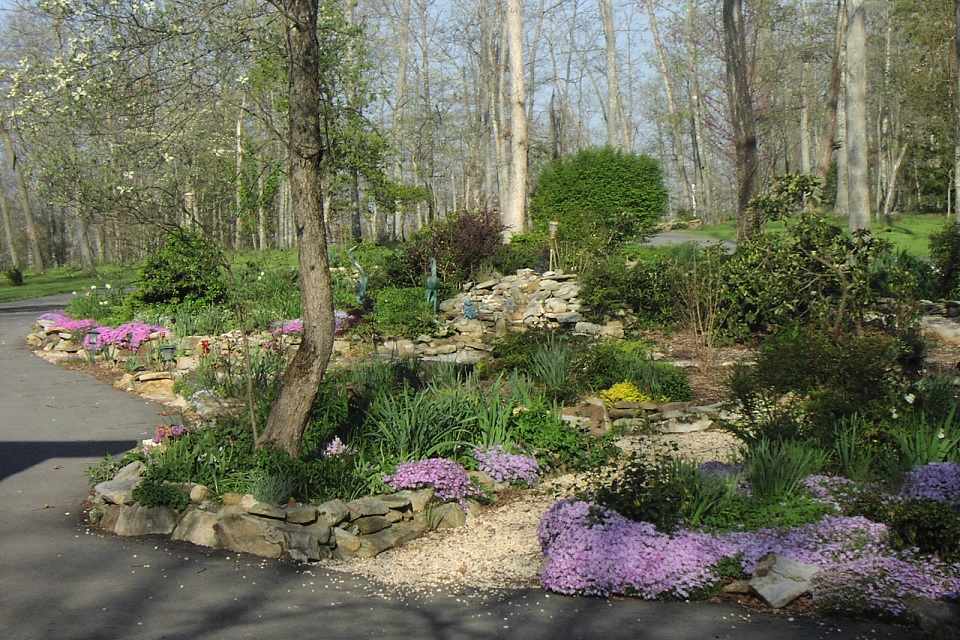
A Striking “Carpet” in the Spring Landscape
Submitted by Carol Burdett, Cumberland County Master Gardener and volunteer with the UT Gardens, Crossville
Creeping phlox is a gardening favorite that many times gets overlooked because some gardeners feel that it loses its appeal once it quits flowering. However, if these evergreen perennial creepers are cut back by half after they are done flowering, the remaining foliage will thicken into an almost impenetrable ground cover. And an occasional flower will pop up now and then over summer.
Botanically known as Phlox subulata (and by many different common names such as creeping phlox, moss phlox, moss pink, or mountain phlox), this plant is native to the eastern and central United States and is widely cultivated. It is a durable perennial that plays well with other plants. It happily produces expanding growth that can be easily transplanted elsewhere, but if you choose to leave it be, it doesn’t crowd out its companions and just snuggles in around taller plants. Because it is such a durable and easily transplanted perennial, creeping phlox is regarded as an old-fashioned plant that is easily passed along from one generation to the next among families and friends.
The small, five-petal flowers bloom in spring to early summer. It is a low plant, forming moss-like mats, with its flowers in clusters at stem ends. Collectively they form a continuous carpet of flowers. A wide array of flower colors are available ranging from white to every shade of pink and purple to almost red and even salmon, and thanks to plant breeders the color palette continues to grow. You’ll also find striped, bi-colored selections and plants with a dark center or “eye.” The evergreen foliage is narrow, short and stiff. Darker-flowered forms have very dark-green leaves or red-tinged leaves that darken to burgundy in winter.
When I was new to gardening and couldn’t get my beautiful creeping phlox to reseed and beget new plants, I complained to a seasoned gardener who asked if I walk on my plants. My horrified response was “Goodness no!” He assured me that was my problem. He said the new seed needed to come in contact with the soil and walking on the plant as the seed ripened allows for this to happen. Yep, that worked.
An alternate plan is deadheading. Because I have more than 40 beds of plants and can’t give them a lot of individual care, I use the weed whacker on them, which works very well. Although I’m not gaining new plants by reseeding, the remaining plants continue to expand. Since they do not die back in winter, there’s no hurry to relocate excess growth. I generally enjoy that process on our occasional warm winter days.
Creeping phlox is best grown in a well-drained soil. Plants grow well in sandy or gravely soils and tolerate hot, dry exposures better than most other species of phlox. It flowers best in full sun but can tolerate partial shade. Plants will self-seed in optimum growing conditions. As mentioned, cut back the stems after flowering by half to maintain form and promote denser growth plus to stimulate a possible light rebloom
Growing just 4-6 inches tall, with plants slowly spreading to 24 inches wide, creeping phlox makes a great plant to use in the foreground of a landscaped bed. Being a die-hard plant tolerating drought and sun, it’s also a great rock garden or xeriscape plant. An extra bonus is that creeping phlox is deer resistant and is a trouble free plant when it comes to garden pests.
Carol Burdett is a Master Gardener with the Cumberland County Master Gardener Association. The Tennessee Master Gardener Program is a volunteer service program that trains and certifies volunteers in the science of horticulture and gardening. MG volunteers provide community service through county Extension offices. For more information, visit the website mastergardener.tennessee.edu or contact your local county UT Extension Office.
The University of Tennessee Gardens located in Knoxville, Crossville and Jackson are part of the UT Institute of Agriculture. Designated as the official botanical garden for the State of Tennessee, the gardens’ mission is to foster appreciation, education and stewardship of plants through garden displays, educational programs and research trials. The gardens are open during all seasons and free to the public except during designated special events. For more information see utgardens.tennessee.edu
Contact:
Patricia McDaniels, UTIA Marketing and Communications, 615-835-4570